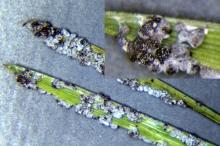See:
Cause Any of several nonparasitic fungi, such as Physarum cinereum, that live on organic debris and use leaf blades as supports during their reproductive phase. They can live on just about anything that remains cool and moist from live plants to basement walls. At some time in their life cycle, the slime mold individuals gather together to form a larger (visible to us) reproductive unit. This unit can creep across surfaces by a process called protoplasmic streaming. These units produce fruiting structures and spores, after which they usually disappear. Slime molds can occur on all grasses. The slime mold Fuligo septica looks like dog vomit or scrambled eggs when seen on turf or mulch.
Symptoms Globular or spherical structures form on grass blades. They may be white or gray and often turn purplish brown. When the structures break, masses of fine, dark spores are released. Slime molds often appear suddenly.
Cultural control Slime molds will disappear if left alone. If desired, break up spore masses by vigorously raking.
Chemical control Some fungicides are registered but are not needed.
Reference Ing, B. 1994. Tansley review no. 62 the phytosociology of myxomycetes. New Phytologist 126:175-201.





